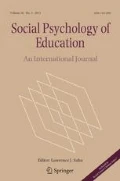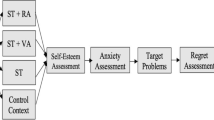Abstract
We examined if an adapted version of a brief social psychological intervention following a multi-threat framework can enhance the mental task performance of female college students under stereotype threat. In experiment 1, under self-as-target stereotype threat, as expected, students who were exposed to the self-affirmation intervention had the highest task performance. However, under group-as-target stereotype threat, we found similar performances of the students in both the self-affirmation and group-affirmation conditions compared to control condition. In experiment 2, we showed that the extent a female student is identified with her gender group moderates the effectiveness of the group-affirmation intervention. The current research encourages researchers to consider different understandings of self while instituting common stereotype threat interventions rather than taking a uniform approach.


Similar content being viewed by others
References
Appel, M., & Kronberger, N. (2012). Stereotypes and the achievement gap: Stereotype threat prior to test taking. Educational Psychology Review, 24, 609–635.
Aron, A., Aron, E. N., Tudor, M., & Nelson, G. (1991). Close relationships as including other in the self. Journal of Personality and Social Psychology, 60, 241–253.
Aronson, J., Lustina, M. J., Good, C., Keough, K., Steele, C. M., & Brown, J. (1999). When White men can’t do math: Necessary and sufficient factors in stereotype threat. Journal of Experimental Social Psychology, 35, 29–46.
Beilock, S. L., Rydell, R. J., & McConnell, A. R. (2007). Stereotype threat and working memory: Mechanisms, alleviation, and spillover. Journal of Experimental Psychology, 136, 256–276.
Brown, R. P., & Pinel, E. C. (2003). Stigma on my mind: Individual differences in the experience of stereotype threat. Journal of Experimental Social Psychology, 39, 626–633.
Cadinu, M., Maass, A., Rosabianca, A., & Kiesner, J. (2005). Why do women underperform under stereotype threat? Psychological Science, 16, 572–578.
Cai, H., Sedikides, C., & Jiang, L. (2013). Familial self as a potent source of affirmation: Evidence from China. Social Psychological and Personality Science, 4, 529–537.
Cohen, G. L., & Garcia, J. (2005). “I am us”: Negative stereotypes as collective threats. Journal of Personality and Social Psychology, 89, 566–582.
Cohen, G. L., & Garcia, J. (2014). Educational theory, practice, and policy and the wisdom of social psychology. Policy Insights from the Behavioral and Brain Sciences, 1, 13–20.
Cohen, G. L., Garcia, J., Apfel, N., & Master, A. (2006). Reducing the racial achievement gap: A social-psychological intervention. Science, 313(5791), 1307–1310.
Cohen, G. L., Garcia, J., Purdie-Vaughns, V., Apfel, N., & Brzustoski, P. (2009). Recursive processes in self-affirmation: Intervening to close the minority achievement gap. Science, 324(5925), 400–403.
Covarrubias, R., Herrmann, S. D., & Fryberg, S. A. (2016). Affirming the interdependent self: Implications for Latino student performance. Basic and Applied Social Psychology, 38(1), 47–57.
Croizet, J. C., Désert, M., Dutrévis, M., & Leyens, J. P. (2001). Stereotype threat, social class, gender, and academic under-achievement: When our reputation catches up to us and takes over. Social Psychology of Education, 4, 295–310.
Danaher, K., & Crandall, C. S. (2008). Stereotype threat in applied settings re-examined. Journal of Applied Social Psychology, 38, 1639–1655.
Eriksson, K., & Lindholm, T. (2007). Making gender matter: The role of gender-based expectancies and gender identification on women’s and men’s math performance in Sweden. Scandinavian Journal of Psychology, 48, 329–338.
Gallagher, A. M., De Lisi, R., Holst, P. C., McGillicuddy-De Lisi, A. V., Morely, M., & Cahalan, C. (2000). Gender differences in advanced mathematical problem solving. Journal of Experimental Child Psychology, 75, 165–190.
Good, C., Aronson, J., & Harder, J. A. (2008). Problems in the pipeline: Stereotype threat and women’s achievement in high-level math courses. Journal of Applied Developmental Psychology, 19, 17–28.
Jamieson, J. P., & Harkins, S. G. (2007). Mere effort and stereotype threat performance effects. Journal of Personality and Social Psychology, 93, 544–564.
Jamieson, J. P., & Harkins, S. G. (2009). The effect of stereotype threat on the solving of quantitative GRE problems: A mere effort interpretation. Personality and Social Psychology Bulletin, 35, 1301–1314.
Jamieson, J. P., & Harkins, S. G. (2011). The intervening task method: Implications for measuring mediation. Personality and Social Psychology Bulletin, 37, 652–661.
Johns, M., Inzlicht, M., & Schmader, T. (2008). Stereotype threat and executive resource depletion: Examining the influence of emotion regulation. Journal of Experimental Psychology: General, 137, 691–705.
Keller, J., & Molix, L. (2008). When women can’t do math: The interplay of self-construal, gender identification, and stereotypic performance standards. Journal of Experimental Social Psychology, 44, 437–444.
Kimball, M. M. (1989). A new perspective on women’s math achievement. Psychology Bulletin, 105, 198–214.
Markus, H. R., & Kitayama, S. (1991). Culture and the self: Implications for cognition, emotion, and motivation. Psychological Review, 98, 224–253.
Martens, A., Johns, M., Greenberg, J., & Schimel, J. (2006). Combating stereotype threat: The effect of self-affirmation on women’s intellectual performance. Journal of Experimental Social Psychology, 42(2), 236–243.
Marx, D. M., Stapel, D. A., & Muller, D. (2005). We can do it: The interplay of construal orientation and social comparison under threat. Journal of Personality and Social Psychology, 88, 432–446.
Miron, M. A., Branscombe, N. R., & Biernat, M. (2010). Motivated shifting of justice standards. Personality and Social Psychology Bulletin, 36, 768–779.
Miyake, A., Kost-Smith, L. E., Finkelstein, N. D., Pollock, S. J., Cohen, G. L., & Ito, T. A. (2010). Reducing the gender achievement gap in college science: A classroom study of values affirmation. Science, 330(6008), 1234–1237.
Moè, A., Meneghetti, C., & Cadinu, M. (2009). Women and mental rotation: Incremental theory and spatial strategy use enhance performance. Personality and Individual Differences, 46(2), 187–191.
Peters, M., Laeng, B., Latham, K., Jackson, M., Zaiyouna, R., & Richardson, C. (1995). A redrawn Vandenberg and Kuse mental rotations test: Different versions and factors that affect performance. Brain and Cognition, 28, 39–58.
Pollock, S. J., Finkelstein, N. D., & Kost, L. E. (2007). Reducing the gender gap in the physics classroom: How sufficient is interactive engagement? Physical Review Special Topic Physics Education Research, 3, 010107.
Rydell, R. J., McConnell, A. R., & Beilock, S. L. (2009). Multiple social identities and stereotype threat: Imbalance, accessibility, and working memory. Journal of Personality and Social Psychology, 96, 949–966.
Scherbaum, C. A., Blanshetyn, V., Marshall-Wolp, E., McCue, E., & Strauss, R. (2011). Examining the effects of stereotype threat on test-taking behaviors. Social Psychology of Education, 14, 361–375.
Schmader, T. (2002). Gender identification moderates stereotype threat effects on women’s math performance. Journal of Experimental Social Psychology, 38, 194–201.
Schmader, T., & Johns, M. (2003). Converging evidence that stereotype threat reduces working memory capacity. Journal of Personality and Social Psychology, 85, 440–452.
Schmader, T., Johns, M., & Forbes, C. (2008). An integrated process model of stereo type threat effects on performance. Psychological Review, 115, 336–356.
Shapiro, J. R. (2011). Different groups, different threats: A multi-threat approach to the experience of stereotype threats. Personality and Social Psychology Bulletin, 37, 464–480.
Shapiro, J. R., & Neuberg, S. L. (2007). From stereotype threat to stereotype threats: Implications of a Multi-Threat Framework for causes, moderators, mediators, consequences, and interventions. Personality and Social Psychology Review, 11, 107–130.
Shapiro, J. R., & Williams, A. M. (2011). The role of stereotype threats in undermining girls’ and women’s performance and interest in STEM fields. Sex Roles, 66, 175–183.
Shapiro, J. R., Williams, A. M., & Hambarchyan, M. (2013). Are all interventions created equal? A multi-threat approach to tailoring stereotype threat interventions. Journal of Personality and Social Psychology, 104(2), 277.
Sherman, D. K. (2013). Self-affirmation: Understanding the effects. Social and Personality Psychology Compass, 7(11), 834–845.
Sherman, D. K., & Cohen, G. L. (2006). The psychology of self-defense: Self-affirmation theory. In M. P. Zanna (Ed.), Advances in experimental social psychology (pp. 183–242). Cambridge: Academic Press.
Sherman, D. K., Bunyan, D. P., Creswell, J. D., & Jaremka, L. M. (2009). Psychological vulnerability and stress: The effects of self-affirmation on sympathetic nervous system responses to naturalistic stressors. Health Psychology, 28, 554–562.
Sherman, D. K., Kinias, Z., Major, B., Kim, H. S., & Prenovost, M. A. (2007). The group as a resource: Reducing biased attributions for group success and failure via group-affirmation. Personality and Social Psychology Bulletin, 33(8), 1100–1112.
Smith, C. S., & Hung, L. C. (2008). Stereotype threat: Effects on education. Social Psychology of Education, 11, 243–257.
Smith, E. R. (1998). Mental representation and memory. In D. Gilbert, S. Fiske, & G. Lindzey (Eds.), Handbook of social psychology (4th ed., Vol. 1, pp. 391–445). New York: McGraw-Hill.
Smith, E. R., Coats, S., & Walling, D. (1997). Correlations of RT facilitation effects with scales measuring group identification. Unpublisheddata, Department of Psychological Sciences, Purdue University
Smith, E. R., Coats, S., & Walling, D. (1999). Overlapping mental representations of self, ingroup, and partner: Further response time evidence and a connectionist model. Personality and Social Psychology Bulletin, 25, 873–882.
Spencer, S. J., Steele, C. M., & Quinn, D. M. (1999). Stereotype threat and women’s math performance. Journal of Experimental Social Psychology, 35, 4–28.
Spitzer, B., & Aronson, J. (2015). Minding and mending the gap: Social psychological interventions to reduce educational disparities. British Journal of Educational Psychology, 85(1), 1–18.
Steele, C. M. (1988). The psychology of self-affirmation: Sustaining the integrity of the self. Advances in Experimental Social Psychology, 21, 261–302.
Steele, C. M. (1997). A threat in the air: How stereotypes shape intellectual identity and performance. American Psychologist, 52, 613–629.
Steele, C. M., & Aronson, J. (1995). Stereotype threat and the intellectual test performance of African Americans. Journal of Personality and Social Psychology, 69, 797.
Steele, C. M., Spencer, S. J., & Aronson, J. (2002). Contending with group image: The psychology of stereotype and social identity threat. Advances in Experimental Social Psychology, 34, 379–440.
Stephens, N. M., Fryberg, S. A., Markus, H. R., Johnson, C., & Covarrubias, R. (2012a). Unseen disadvantage: How American universities’ focus on independence undermines the academic performance of first-generation college students. Journal of Personality and Social Psychology, 102, 1178–1197.
Stephens, N. M., Townsend, S. S. M., Markus, H. R., & Phillips, L. T. (2012b). A cultural mismatch: independent cultural norms produce greater increases in cortisol and more negative emotions among first-generation college students. Journal of Experimental Social Psychology, 48, 1389–1393.
Strenta, A. C., Elliott, R., Adair, R., Matier, M., & Scott, J. (1994). Choosing and leaving science in highly selective institutions. Research Higher Education, 35(5), 513–547.
Tajfel, H. (1981). Human groups and social categories: Studies in social psychology (p. 369). Cambridge: Cambridge University Press.
Tajfel, H., & Turner, J. C. (1979). An integrative theory of intergroup conflict. In W. G. Austin & S. Worchel (Eds.), The social psychology of intergroup relations (pp. 33–47). Monterey, CA: Brooks/Cole.
Triandis, H. C. (1990). Cross-cultural studies of individualism and collectivism. In J. Berman (Ed.), Nebraska symposium on motivation (pp. 41–133). Lincoln: University of Nebraska Press.
Tropp, L. R., & Wright, S. C. (2001). Ingroup identification as the inclusion of ingroup in the self. Personality and Social Psychology Bulletin, 27, 585–600.
Van Camp, A. R., Gilbert, P. N., & O’Brien, L. T. (2019). Testing the effects of a role model intervention on women’s STEM outcomes. Social Psychology of Education, 22, 649–671.
Vanderberg, S. G., & Kuse, A. R. (1978). Mental rotations, a group test of three-dimensional spatial visualization. Perceptual and Motor Skills, 47, 599–604.
Walton, G. M., & Spencer, S. J. (2009). Latent ability: Grades and test scores systematically underestimate the intellectual ability of negatively stereotyped students. Psychological Science, 20, 1132–1139.
Author information
Authors and Affiliations
Corresponding author
Additional information
Publisher's Note
Springer Nature remains neutral with regard to jurisdictional claims in published maps and institutional affiliations.
Rights and permissions
About this article
Cite this article
Çetinkaya, E., Herrmann, S.D. & Kisbu-Sakarya, Y. Adapting the values affirmation intervention to a multi-stereotype threat framework for female students in STEM. Soc Psychol Educ 23, 1587–1607 (2020). https://doi.org/10.1007/s11218-020-09594-8
Received:
Accepted:
Published:
Issue Date:
DOI: https://doi.org/10.1007/s11218-020-09594-8



